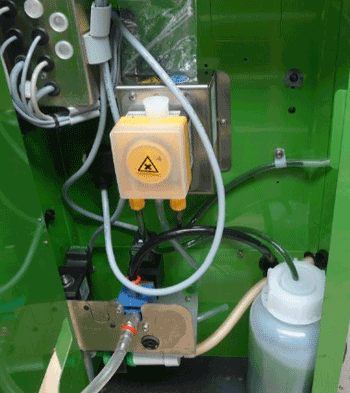Automated Calf Feeders and Celmanax®, A Great Combination
Charlie Elrod, Ph.D. Dairy Division Manager
Winter is a time when we struggle to keep calves fed and calves struggle to stay warm and grow. Add a pathogen challenge to their environmental and nutritional challenges and we often see calves going backwards, or worse, breaking with clinical scours or pneumonia. Combining the proven technologies of Celmanax with automated calf feeding can help dairies meet these challenges.
Celmanax
All around the world, Vi-COR® staff is working with dairy producers who are adopting the use of automated calf feeders. This technology is providing some real benefits to managers and the calves in their care. With the addition of either the liquid or dry medicator units, it becomes even easier to bring in the advantages of Celmanax technology. Below are pictures from a dairy in Costa Rica of an automated feeder with a liquid medicator for use with Celmanax. The pump, in the center of Figure 1, delivers 4 mL of Celmanax Liquid during two of the eight feedings each day, for a total of 8 mL of Celmanax/calf/day. Dr. Jaime Murillo, the veterinarian who owns this farm, attributes improved weight gains and reduced disease incidence to this combination of technologies. As you can see from the cleanliness of the pen and equipment in the Figure 2, this technology has been adopted into a system that is already very well managed.


Figure 2 at right. That is a key point, according to Dr. Mike Van Amburgh, a calf researcher at Cornell University. "This is great technology, but it does not absolve the manager of responsibility for taking care of the other aspects of calf management". Best practices, such as calving pen cleanliness, timely colostrum feeding, adequate housing and a sound vaccination program will all help the calf to grow at the rates allowed by her genetic potential and good nutrition. "Some of our early research on feeding frequency for calves showed that feeding the same amount of milk, but splitting it across more meals, increases feed efficiency by as much as 15%. That's one of the great advantages of the automated feeding systems" says Van Amburgh.
We also know that even in the best managed facilities, calves will be exposed to pathogens which impair gut health and reduce growth rates. No dairy can provide a sterile environment for their calves. There will always be some level of exposure to pathogens such as E. coli, Salmonella or Cryptosporidium. This is where Celmanax really comes into play. With the consistent, twice-daily delivery of the Mannan Oligosaccharide (MOS) and Galactosamine components of Celmanax, the pathogenic challenges to the calf's gut are significantly reduced. Figure 3 is a composite graph, with data from several of Vi-COR's sponsored research projects, showing the reduction in free pathogen cells (non-agglutinated) or the reduction in pathogen attachment to cultured intestinal cells. Across several pathogen types (E. coli, Salmonella and Cryptosporidium), and differing measures of pathogen activity (agglutination or attachment), Celmanax significantly reduces the pathogens' ability to bind to and infiltrate the cells of the intestine in comparison to the control.

The benefits of Celmanax can extend beyond gut health as well. In a recent study of young feedlot calves at Texas Tech University, Celmanax reduced the incidence of respiratory disease from 10.5% to 4.1%. This may be a systemic immune effect from the beta-glucan fraction, or a redcution in other challenges which allowed for a more robust immune response to the respiratory disease agents. In either case, calves consuming Celmanax required fewer antibiotic treatments and had higher average daily gains. This improvement in calf health combined with the increase in gain observed when Celmanax is fed in milk replacers, makes this a great combination for the calf as well as the producer.
Here are a few key points for adopting the dual technologies of automated feeding and Celmanax for your calves:
- If housing calves of different ages in the same pen, use two feeding stations with one of them just big enough for the 1-14 day old calves. This will reduce competition from older calves.
- Use the time gained from automating feeding chores to manage other aspects of the calves more closely. Dehorning, sanitation, growth assessment, and vaccinations are just a few.
- Use the data collected from the feeder to evaluate feeding patterns each day and catch off-feed or sick calves before they go downhill.
- Practice good biosecurity and sanitation, but also include Celmanax, either Liquid or SCP, to catch those pathogens that will inevitably get into the calf.
2.07.2011